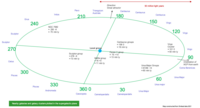Supergalactic coordinate system

Imagine you are playing hide and seek with your friends in a really, really big park. The park is so big that you need a special way to describe where you are hiding. That's kind of like what astronomers do when they study things in space.
A supergalactic coordinate system is like a giant map that helps astronomers describe where things are in our universe. It's a way to keep track of all the different galaxies and clusters of galaxies we know about.
Instead of using regular up and down, left and right directions like on a regular map, the supergalactic coordinate system has its own special directions. These directions are based on the biggest thing we know about in our universe: clusters of galaxies.
A cluster of galaxies is a group of lots and lots of galaxies that are all close together. They're kind of like cities in space. Scientists use these clusters to help create the supergalactic coordinate system.
When you're using the supergalactic coordinate system, the center or "home base" is the center of our own Milky Way Galaxy. From there, the directions are based on where we see the biggest clusters of galaxies.
So if you were to look up at a clear night sky and see a galaxy floating out there all by itself, an astronomer using the supergalactic coordinate system would be able to describe exactly where it is in relation to big clusters of galaxies. They might say it's so many degrees away from the center of the closest big cluster, for example.
Overall, the supergalactic coordinate system helps scientists keep track of all the different things out in space and how they're related to each other.
A supergalactic coordinate system is like a giant map that helps astronomers describe where things are in our universe. It's a way to keep track of all the different galaxies and clusters of galaxies we know about.
Instead of using regular up and down, left and right directions like on a regular map, the supergalactic coordinate system has its own special directions. These directions are based on the biggest thing we know about in our universe: clusters of galaxies.
A cluster of galaxies is a group of lots and lots of galaxies that are all close together. They're kind of like cities in space. Scientists use these clusters to help create the supergalactic coordinate system.
When you're using the supergalactic coordinate system, the center or "home base" is the center of our own Milky Way Galaxy. From there, the directions are based on where we see the biggest clusters of galaxies.
So if you were to look up at a clear night sky and see a galaxy floating out there all by itself, an astronomer using the supergalactic coordinate system would be able to describe exactly where it is in relation to big clusters of galaxies. They might say it's so many degrees away from the center of the closest big cluster, for example.
Overall, the supergalactic coordinate system helps scientists keep track of all the different things out in space and how they're related to each other.
Related topics others have asked about:
